From the early 1990s, the Internet began its climb to become an available-to-all resource. As the generation that grew up comfortably in its embrace now forms a large consumer base, more and more companies have to work on their social media engagement.
To remain relevant today, businesses have now resorted to maintaining company profiles on Facebook, Instagram, LinkedIn, Pinterest, and more. And why not? With 2.8 billion users on Facebook, it would be folly to not make use of the platform.
But managing 6-7 accounts at once is not easy. Agencies now have dedicated staff members who work on generating graphic posters, engaging captions and optimised content. To stand out amongst hundreds of others, one has to constantly be on the lookout for trending topics and keywords, post at the right time, and monitor its performance.
Does this not sound like a one-man job? This is where social media management tools come in! While there are hardly any forever free options, most offer 7 to 30-day free trial periods that you can check out.
How Such Tools Can Boost Performance
Social media management involves effectively managing a company online interactions ranging from posting content to replying to comments to solving complaints. Generally, a social media manager is placed in charge of such a task.
However, providing them with the right tools can make the job infinitely easier. Let’s say you have a specialised post for the New Year coming up. You have identified 9 PM as the most engaging hour.
What happens if someone forgets to post it or the internet gives out? Management tools can help you schedule these things in advance! This is just one of the many roles it performs. These tools can boost performance by:
- The apps provide a single platform via which you can control multiple profiles on different platforms.
- Advance scheduling and posting features, mock layouts.
- See the analytics and performance of every post, track users and their activity.
- Follow competitor’s performance.
- Look for trending topics and keywords within the tool itself rather than emptying a third-party tool.
And of course, having one platform streamlines the entire process and makes managing your social media a cost-effective affair.
What To Look For In Social Media Management Tools
Generally, all tasks performed by these tools fall under three major categories, which are:
- Scheduling and Publishing
- Reports and Analytics
- Tracking and Engagement
There are many paid and free social media management tools on the market. But which one should you use? That depends on the kind of platforms you are active on and the features you need. Here are some things to keep in mind while opting for such tools.
- How strong its “Listening” or competitor tracking performance is
- The usability of its keyword research tool
- The breakdown provided for user demographics and views
- How many and what types of platforms it supports
- The alerts and notifications offered
- The kinds of mockups, previews and scheduling feature it has
- Pricing and collaborative features
With these out of the way, let’s take a look at the best free tools available!
Best Free Tools For Social Media Management
1. Hootsuite
Those looking for a tool with strong analytics can rely on Hootsuite. As far as management tools go, Hootsuite is at the top of its game with its scheduling and tracking features. With Hootsuite, you can manage almost every social media platform. Their supported platforms include Facebook, Twitter, YouTube, LinkedIn, Instagram, WordPress and more.
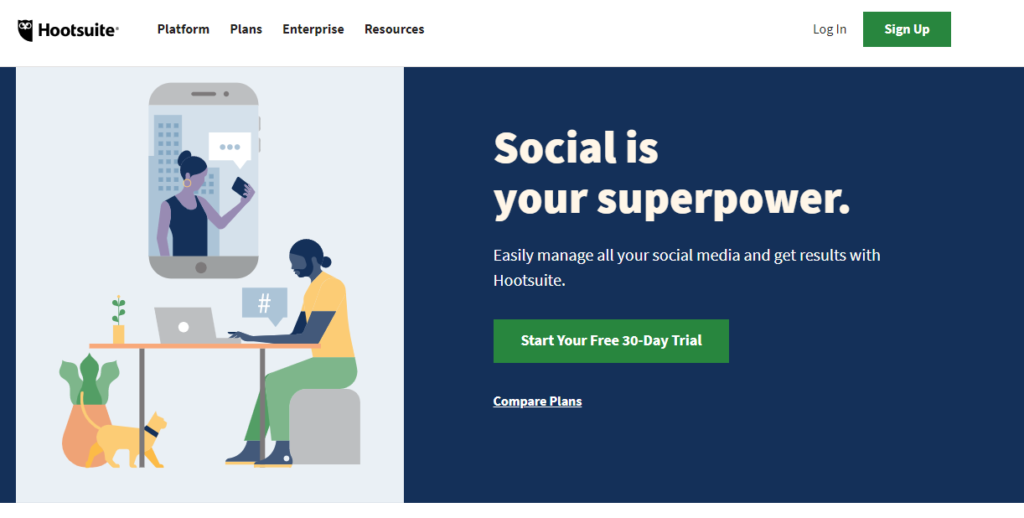
Hootsuite offers an extremely visual planning calendar. You can simply drag and drop posts on to a particular day if you want to schedule it. Along with this, Hootsuite offers exclusive access to its own image and content library. Their team is working on providing seamless video streaming across all supported platforms.
The workspace is collaborative. You can set up each post to go through an approval process before it is posted. This means, unless the stakeholders approve of it, it will not go through.
Hootsuite’s reports are its strong point. One can easily access the analytics for any platform. This includes followers gained, total insights, the overall traffic, most clicked links and user demographics. Want to track your competitor? With Hootsuite, you can add your competitor’s channel and perform an analysis.
Hootsuite also offers hundreds of integrations and can work with an existing CRM or email automation tool. This makes it perfect for SMBs relying on an interconnected system. Hootsuite offers a free 30-day plan.
Key Features
- Various platform support
- Publishing tools in one place
- Scheduling tools in one place
- Visual content Planning calendar
- Competitor analysis
- Strong reports and analytics
- Hundreds of Integrations
- Collaboration and approval workflow
2. Buffer
Buffer is undoubtedly one of the simplest and yet effective management tools out there. Made specifically for SMBs running on limited human capital, Buffer provided a fun and interactive dashboard that suits even new users.

Buffer offers a virtual workspace within which a team can plan its daily content. For platforms like Instagram, it allows you to schedule the first comment on your post. This comment can contain all the necessary tags, thus making your caption look cleaner.
You can set up notifications for each post before it is actually posted. It also offers a mock grid for you to keep your feed aesthetic. Buffer works best for Instagram as it allows you to create a shop grid and integrate a link in the bio where users can access all products.
However, it also performs well for other platforms. For drafting text posts, you can work as a team and assign a leader whose approval is required. As for analytics, with Buffer, you can check post insights, insights for stories, videos and reels. Their analytics includes follower growth, impressions, insights, reach, comments and more.
Using the Buffer desktop app, you can reply to comments without even opening the platform. It also shows a mock view of your posts with the comments and likes beside it so you can easily jump to which one you want. Buffer has a forever free plan that you can use to manage up to 3 social channels.
Key Features
- Up to 25 social channels allowed
- Publishing tools in one place
- Scheduling tools in one place
- Visual content Planning calendar
- Extremely aesthetic workspace
- Strong reports and analytics
- Collaboration and approval workflow
- Mock views and grid layouts
3. Social Web Suite
Social Web Suite is made for professionals. They have a wide range of features and integrations that one can choose from. Forget the hassle of datasheets and Excel.
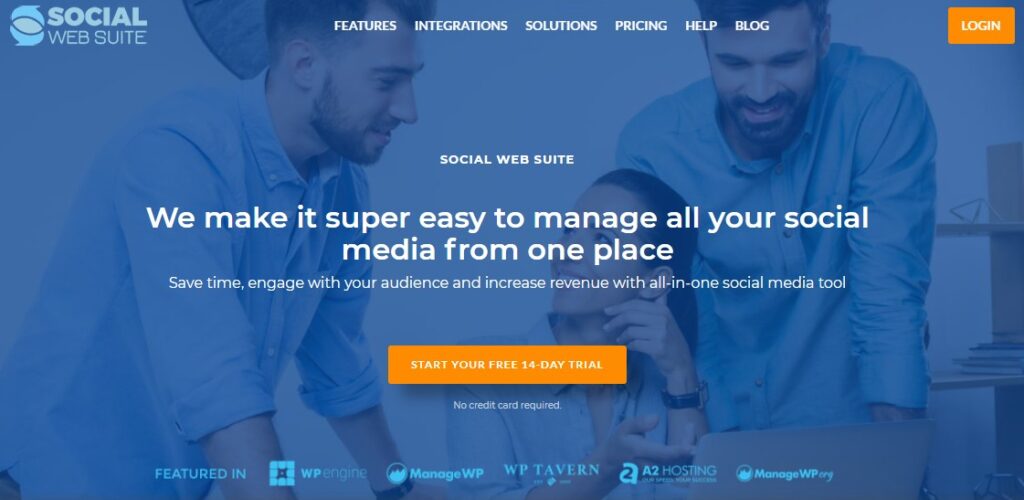
With Social Web Suite, you can view a social media marketing calendar that allows direct editing and posting. The content calendar allows one to see the scheduling trends by the day, week or month. It also alerts users of any upcoming festivals and holidays.
Each post can be tracked using Google Analytics. Simply add the UTM parameters to the link.
Currently, Social Web Suite supports WordPress, RSS Feeds, Facebook, Twitter, LinkedIn, and Bitly.
This means you can access the comments, views and engagement of all these platforms on the Social Web Suite platform itself. You can also publish directly onto all these platforms from the Social Web Suite dashboard. And the best part? You can directly integrate Social Web Suite into your WordPress site with their WordPress plugin.
Social Web Suite offers a free 14 days trial period for those interested in it. If you are satisfied with its performance, you can start with its smallest plan that comes in at 9 USD per month. This allows a single user to run up to 5 different accounts.
Key Features
- Can support 5 platforms
- Publishing tools in one place
- Scheduling tools in one place
- Content Planning calendar
- Has a WordPress Plugin
- Insights
4. CoSchedule
There is a reason why brands like Yamaha and Forbes use CoSchedule. CoScheudle works best for large companies where a team may consist of many members and departments. When a single post must pass through a large approval channel – that’s when you need CoSchedule.
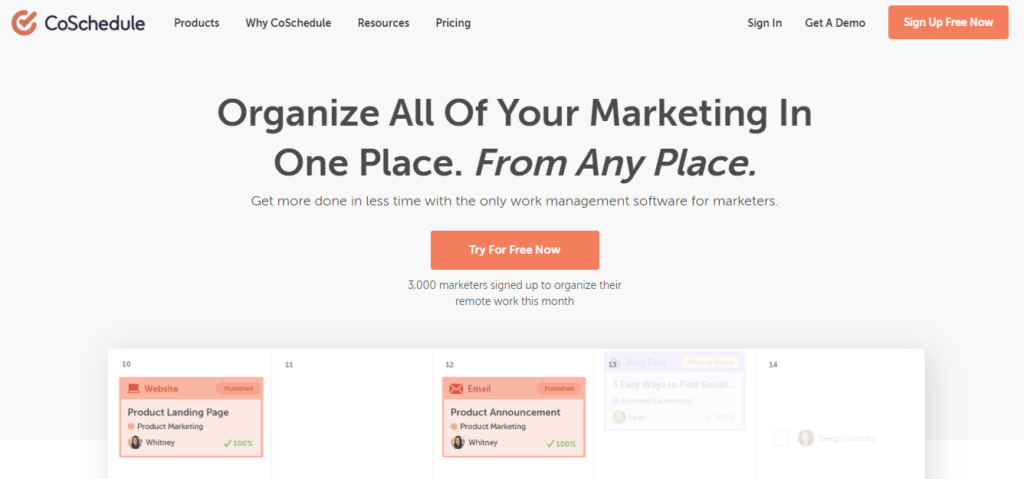
CoSchedule offers a Marketing Calendar where one can schedule tasks, update their work progress and have the stakeholders or higher-ups update their approval. Once done, the post gets marked for scheduling – all in one single space! If you are working with many other departments in tow, then CoSchedule offers an entire marketing suite.
The Marketing Suite has a calendar, work organiser, content organiser and asset organiser. The asset organiser can contain a file library and allow easy sharing between departments. The work organiser keeps a track of each project along with the milestones reached. The work organiser acts as a Content marketing software that allows publishing, promotion and attracting of leads.
All in all, CoSchedule offers an all-in-one scheme that larger agencies might find very useful. In fact, after posting content, you can even share it in the form of an email or RSS feed by integrating CoSchedule with an email automation platform like MailChimp! CoSchedule offers a 14 days free plan that you can try out.
Key Features
- All-in-one marketing suite
- Great analytics and reports
- Collaborative and approval workflow
- Content and asset organiser
- Agile methodology
- Integrates with email services
5. Sendible
If you are looking for an all-around tool that can even help you to create your posts, then Sendible is the one for you. Not only does it support 6 different platforms, but Sendible also works equally well for image posts, blog posts, video posts and podcasts.
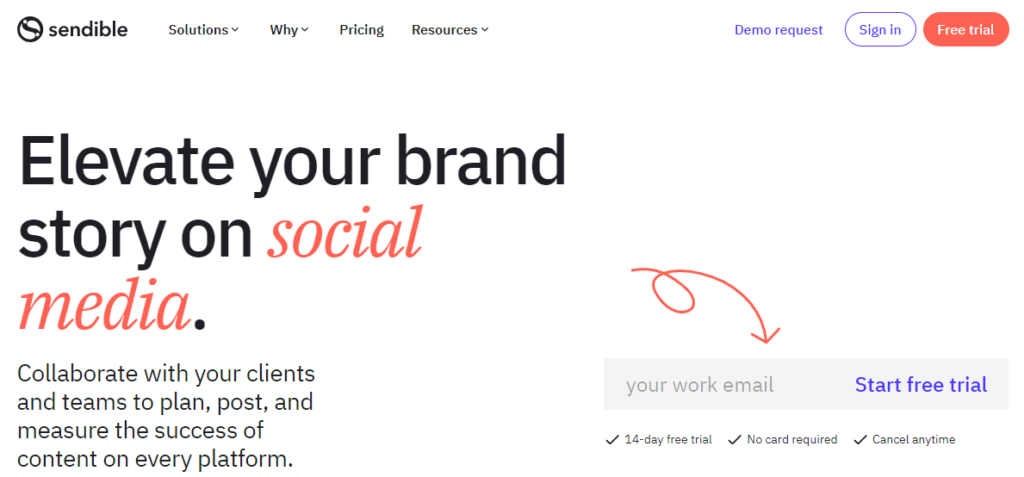
Sendible offers unique guides and templates that businesses can use to generate their content. This includes templates for Instagram, Pinterest and so on. Apart from this, the Sendible website offers both free and paid tutorials for new users.
The Sendible dashboard is extremely intuitive and features updates for all platforms in one place. Similarly, they offer a single content planner for all platforms. The platforms are colour coded for differentiation. With the Sendible mobile app, you can work from anywhere!
Sendible offers in-depth reports which you can customise and download as PDFs for forwarding. You can get a 14-days free trial anytime.
Key Features
- Competitor listening
- Strong analytics, customised reports
- Single dashboard and planner
- Collaborative and approval workflow
- Scheduling of posts
- Can support podcasts and video posts
6. Sprout Social
Wondering what your competitors are doing? Sprout Social is the tool to use for that! With all its features, Sprout Social’s social listening tool stands out. With this tool, you can easily track your competitor’s performance, check out their top-performing keywords, hashtags and platforms.
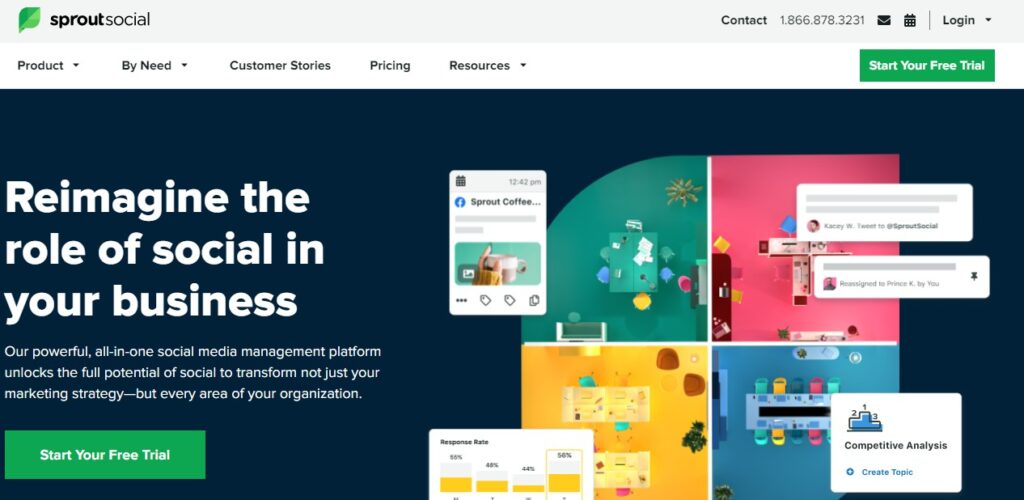
Not only this, but Sprout Social also offers its very own in-built keyword research tool. This tool allows you to track current trends which you can convert into hashtags for usage. As for scheduling and publishing, Sprout Social offers a visual calendar.
If you are not sure about the exact time to post it, you can leave it to the Sprout Social AI to track and figure out the best time for that location. They also offer an Asset Library. You can track your posts with Google Analytics, create Approval Workflows or get content suggestions from the tool itself.
Their engagement dashboard is created to save time. You can access the top-performing posts and unanswered comments without even opening the posts! Secure your account with two-factor authentication. Sprout Social offers a 30-day free plan.
Key Features
- Content suggestions
- Posting time optimisation
- Great analytics and reports
- Collaborative and approval workflow
- Asset library
- Intuitive dashboard
- Inbuilt keyword research tool
- Social listening
7. Edgar
Looking to save time and energy? Edgar offers a comprehensive scheduling tool, full of keyboard shortcuts and easy navigation features to allow you to respond and manage posts quickly. Edgar works with Facebook, Twitter, Instagram, Pinterest and LinkedIn.
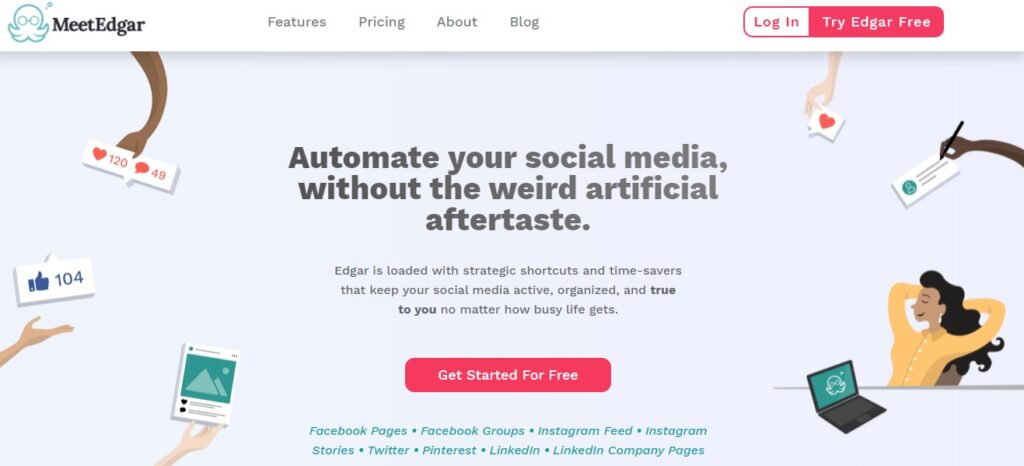
Edgar’s best feature is its scheduling tool. While it does have a content planning calendar, the Edgar AI offers post automation as well. So if you are planning on a Podcast every Wednesday, you can simply add it to Edgar’s list of tasks. You can create a content library and select an order of posting or ask Edgar to mix it up based on hashtags and current interests.
Running out of ideas? Edgar will keep updating you on trending ideas as and when needed. Another strong feature offered is the A/B testing options. A/B testing is generally not seen in social media tools and it’s great that Edgar offers this feature. You can track link performance, post insights and user active hours.
Edgar’s main focus is on automating tasks and making them easier and quicker. Hence, it has a strong analytics report, hashtag understanding and automation tools. But for setting up of workflows, the tool lacks behind. You can use Edgar free for 7 days.
Key Features
- Content suggestions
- Posting automation
- Great analytics and reports
- A/B Testing
- Asset library
- 6 platform support
8. Sked Social
Sked Social is specifically made for Instagram users, but can also support Twitter, LinkedIn, Facebook and Pinterest. Sked Social works as an exemplary scheduling tool. They not only allow customized scheduling but customized time schedule based on user locations as well! Most of their features are directed towards Instagram users.
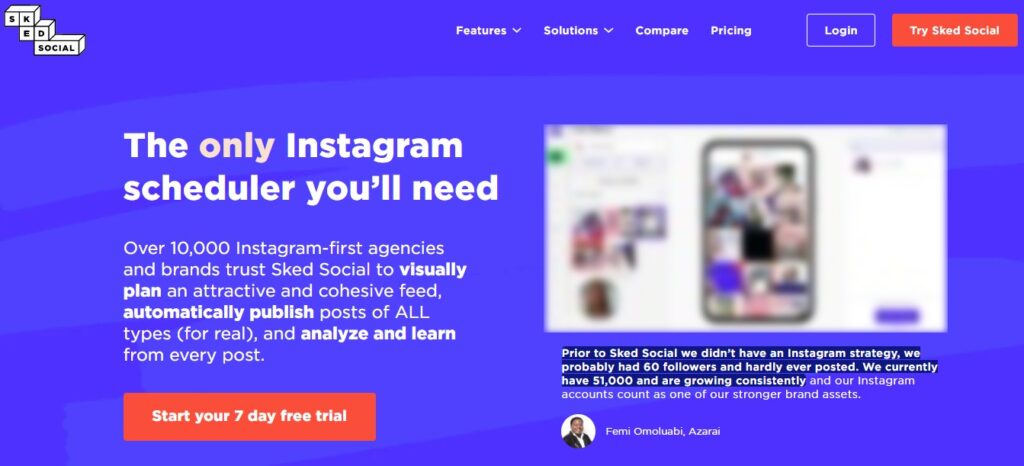
Hence, Sked Social offers a mock Instagram grid layout, insights for stories and reels, and hashtag alerts. You can use its in-built keyword tool to find hashtags and keywords based on locations. Sked Social allows you to add product tags on your posts and add links on posts that direct users to a website.
It also offers advanced analytics for Instagram only that includes time-based breakdowns. Just like the social calendar, you can also review your insights in the form of a calendar and see which day had the best reach.
Like the other tools, it allows collaboration and setting up of an approval workflow. Teams can comment on the image or posts stored in the asset library itself. Sked Social has a free 7 days plan but is well worth the money spent on higher plans.
Key Features
- Keyword research tool
- Posting time optimization
- Great analytics and reports
- Collaborative and approval workflow
- Asset library
- Location and time-based performance
- Publer
Though relatively new, Publer has the largest range among all listed tools. They can schedule and publish posts on multiple platforms including lesser-known ones. And most importantly, they offer a forever free account!
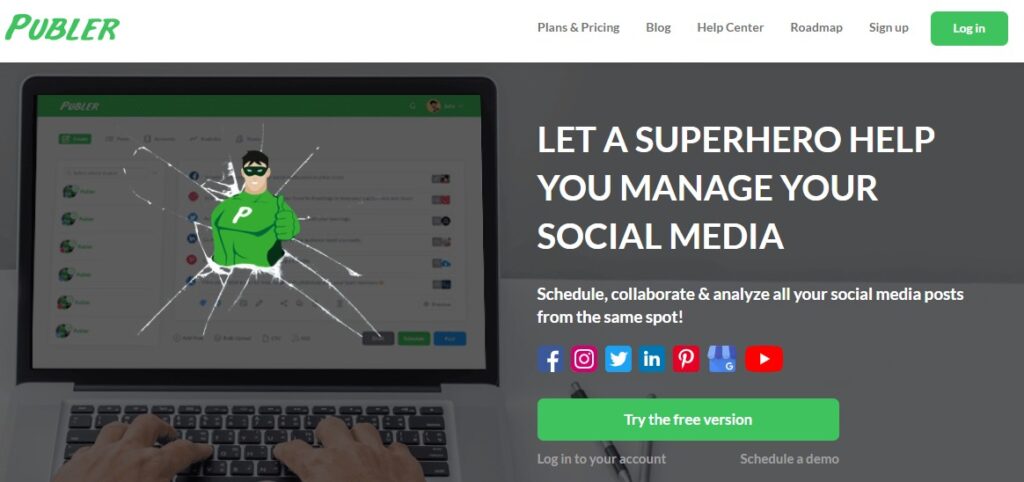
Publer’s best feature is that they allow mock previews for every single platform they support. So if you are going to post an image and text post on Facebook, you can see exactly where Facebook will place the “See More” option.
For Instagram, you can explore a mock-grid layout. Apart from this, Publer allows link shortening, direct uploading from URLs, calendar views, a browser extension and a built-in photo editor.
While most might get their graphics work done on another platform, SMBs might find Publer’s all-in-one approach quite welcoming. With paid accounts, you can get a direct Canva Integration itself! Another interesting feature is that you can automate reports on Publer and have them directly delivered to your inbox. Paid accounts can also access their keyword research tool and get content suggestions.
Key Features
- Keyword research tool
- Content suggestions
- Reports in inbox
- Mock layouts for all
- In-built photo editor
- Canva Integration
- Unlimited storage space
10. Ryzely
Ryzely allows one user to manage an unlimited number of social accounts and also schedule an unlimited number of posts. This is incredible seeing that most allow around 5 to 25 accounts and up to 500 posts only.
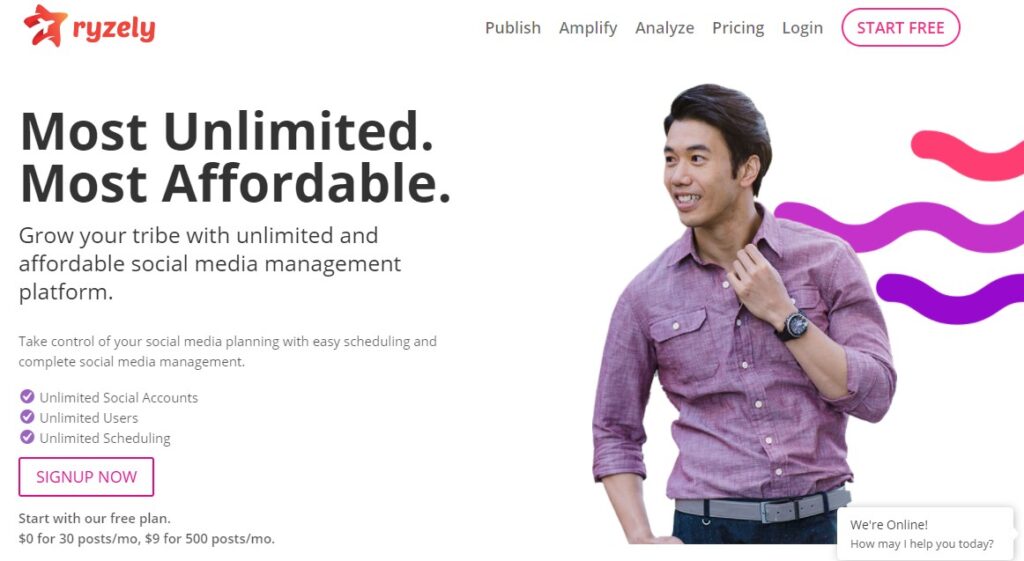
Ryzely also allows an unlimited number of people to collaborate on a single project. This means a single account can be used by many people. With a mock editor, Ryzely allows you to write posts and see the preview side by side on its mock-up screen.
It also offers content scheduling but unlike the other tools, this is in a linear form and not in a calendar form. Ryzely has a forever free account that offers most features that a small business would need. But with the paid account, one can even optimise posting times based on the user’s timezones.
Ryzely also has the most detailed insights of the lot. One can see an overview of comments, clicks, impressions, reach, reactions and more. It also keeps a track of negative comments and feedback using an AI to search through the words.
Key Features
- Unlimited people and accounts
- Forever free version
- Great analytics and tracking
- Real-time mock editor
- Location-based optimisation
- Can conduct hashtag research
Conclusion
Each tool discussed has its own pros and cons. And it really depends on whether you need specific features or not. Do you need a Canva Integration? Or an in-built keyword research tool? Your preference must be unique to your company’s needs.
Social media has emerged as a crucial part of our lives and leveraging the trend can only result in success. If you are looking for plugins, then the options are quite a few. Some like Revive Old Post are available in the form of WordPress plugins, rather than a separate tool. Social Web Suite also has its own WordPress plugin for post scheduling. Some like Publer offer browser extensions instead. Sendible has its own iOS and Android app.
Overall, these are some of the top tools available and there is no doubt as to their overall performance or customer support. Let me know what other tools you have used and your experience with them!